Related Research Articles

Emil Theodor Kocher was a Swiss physician and medical researcher who received the 1909 Nobel Prize in Physiology or Medicine for his work in the physiology, pathology and surgery of the thyroid. Among his many accomplishments are the introduction and promotion of aseptic surgery and scientific methods in surgery, specifically reducing the mortality of thyroidectomies below 1% in his operations.
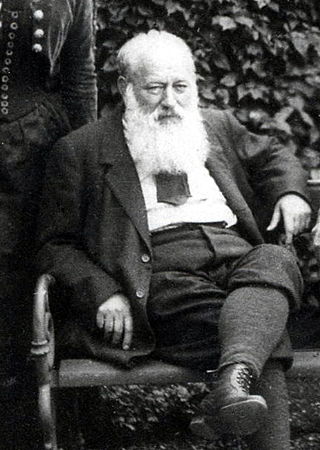
Christian Albert Theodor Billroth was a German surgeon and amateur musician.

A gastrectomy is a partial or total surgical removal of the stomach.
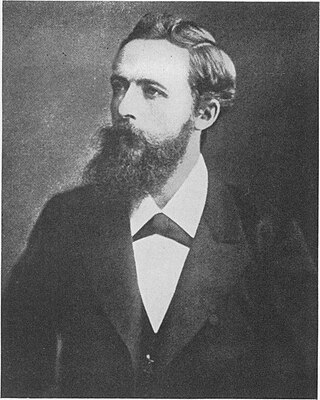
Jan Mikulicz-Radecki was a German-Polish-Austrian surgeon who worked mainly in the German Empire. He was born on 16 May 1850 in Czerniowce in the Austrian Empire and died on 4 June 1905 in Breslau, German Empire. He was professor in Kraków, Breslau, and Königsberg. He was the inventor of new operating techniques and tools, and is one of the pioneers of antiseptics and aseptic techniques. In Poland he is regarded as one of the founders of the Kraków school of surgery.
Whonamedit? is an online English-language dictionary of medical eponyms and the people associated with their identification. Though it is a dictionary, many eponyms and persons are presented in extensive articles with comprehensive bibliographies. The dictionary is hosted in Norway and maintained by medical historian Ole Daniel Enersen.

A vagotomy is a surgical procedure that involves removing part of the vagus nerve. It is performed in the abdomen.
Billroth may refer to:

Carl Gussenbauer was an Austrian surgeon.
Dennis L. Fowler is the Vice President and Medical Director for Perioperative Services at NewYork-Presbyterian Hospital/Columbia University Medical Center. He is a pioneer in the field of endoscopic surgery and has been the first to perform numerous innovative laparoscopic surgical procedures, never before accomplished (NYP). Fowler was also the first general surgeon to use the Harmonic Scalpel, a device that uses wave frequency to divide the tissue and vibration to coagulate blood vessels.
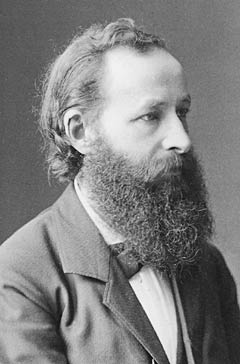
Robert Michaelis von Olshausen was a German obstetrician and gynecologist. He was born in Kiel and died in Berlin. He was the son of Justus Olshausen (1800–82), a professor of Oriental languages at the University of Kiel.
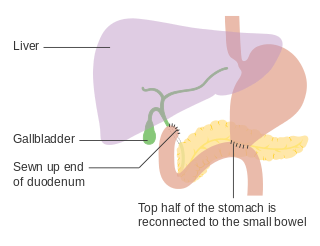
Billroth II, more formally Billroth's operation II, is an operation in which a partial gastrectomy is performed and the cut end of the stomach is closed. The greater curvature of the stomach is then connected to the first part of the jejunum in end-to-side anastomosis. The Billroth II always follows resection of the lower part of the stomach (antrum). The surgical procedure is called a partial gastrectomy and gastrojejunostomy. The Billroth II is often indicated in refractory peptic ulcer disease and gastric adenocarcinoma.
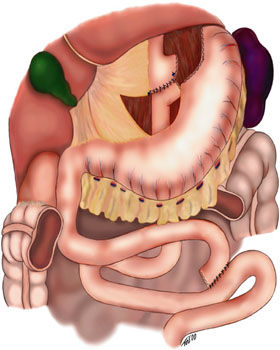
In general surgery, a Roux-en-Y anastomosis, or Roux-en-Y, is an end-to-side surgical anastomosis of bowel used to reconstruct the gastrointestinal tract. Typically, it is between stomach and small bowel that is distal from the cut end.
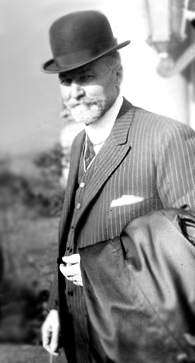
John Benjamin Murphy, born John Murphy was an American physician and abdominal surgeon noted for advocating early surgical intervention in appendicitis appendectomy, and several eponyms: Murphy’s button, Murphy drip, Murphy’s punch, Murphy’s test, and Murphy-Lane bone skid. He is best remembered for the eponymous clinical sign that is used in evaluating patients with acute cholecystitis. His career spanned general surgery, orthopedics, neurosurgery, and cardiothoracic surgery, which helped him to gain international prominence in the surgical profession. Mayo Clinic co-founder William James Mayo called him "the surgical genius of our generation".
Hans Finsterer was an Austrian surgeon.
The Hofmeister–Finsterer operation is a partial gastrectomy, devised by Franz von Hofmeister, based upon a procedure by Eugen Pólya. It was later refined by Hans Finsterer and became known as the Hofmeister–Finsterer gastrectomy. Here upper part of the cut end of the stomach is closed and remaining lower portion is anastomosed with jejunum.
Jenő Sándor Pólya, German: Eugen Alexander Pólya, Hungarian: Pólya (Pollák) Jenő Sándor was a Hungarian surgeon who was a native of Budapest. He was the brother of George Pólya (1887–1985), who was a professor of mathematics at Stanford University.
A gastrojejunocolic fistula is a disorder of the human gastrointestinal tract. It may form between the transverse colon and the upper jejunum after a Billroth II surgical procedure. Fecal matter thereby passes improperly from the colon to the stomach, and causes halitosis.
Billroth Hospitals is a hospital chain which is based in Chennai, Tamil Nadu, India. It was founded by Dr. V. Jeganathan on 30 November 1990. Billroth Hospital has its branches in Shenoy Nagar, R A Puram, and Tiruvallur.

The Wertheim–Meigs operation is a surgical procedure for the treatment of cervical cancer performed by way of an abdominal incision.
Dittrichin Siegmundin was a German obstetrician named as a possible re-inventor of nooses and blunt hooks for turning or extracting an infant in difficult births. She was the first, along with Francois Mauricaeu, to apply the technique of puncturing the amniotic sac to arrest hemorrhaging in placenta praevia. During this time, she studied the correct amount of use of these tools and wrote about the importance of not overusing or abusing these tools and procedures. She studied the instruments and procedures of obstetrics from books and practice alongside peasant women for nearly 12 years. In 1689 her first book was published, and reprinted six times, for midwives reflecting on all of the notes and illustrations she kept with each delivery in her practice. She eventually became the midwife to the Court of the Elector of Brandenburg in the royal family of Prussia and one of the most celebrated of the German midwives of the 17th century.
References
- 1 2 "Gastroduodenostomy - procedure, recovery, blood, tube, removal, pain, time, operation". www.surgeryencyclopedia.com. Retrieved 2017-04-16.
- 1 2 Billroth's operation I. whonamedit.com. http://www.whonamedit.com/synd.cfm/2730.html. Accessed on: June 15, 2008.